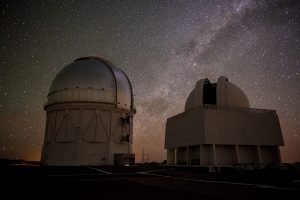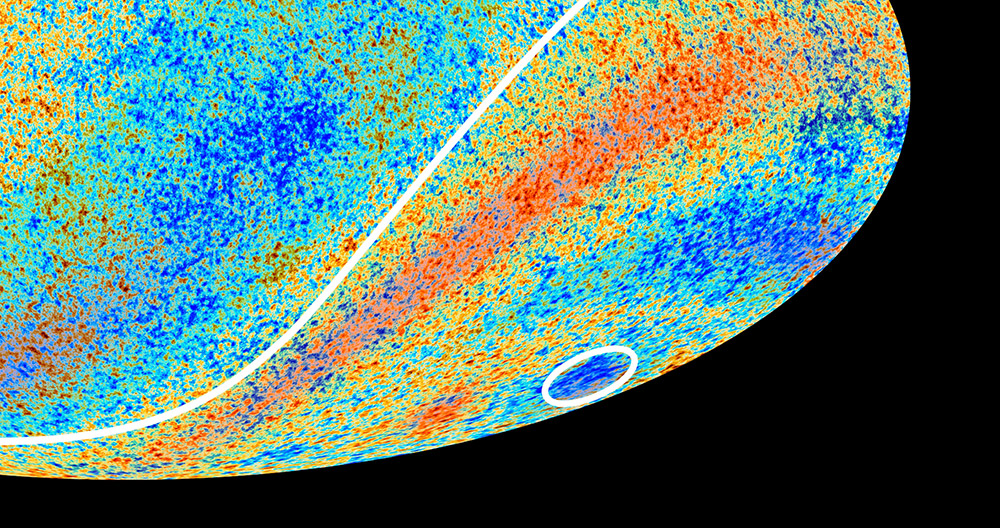A mysterious anomaly: Astronomers have studied a possible explanation for the mysterious cold spot in the cosmic microwave background — but even they can’t quite solve the mystery. The massive area in the foreground causes part of the anomaly detected. However, the effect of this “super vacuum” raises new questions because it is larger than cosmological models predict.
whole universe from cosmic background radiation Penetrating through it are omnipresent microwaves dating back 380,000 years after the Big Bang. Temperature fluctuations are reflected by this radiation The nuances It is reflected in the distribution of energy and mass in the early universe. It also allows drawing conclusions about the proportions of dark matter and dark energy So is the expansion rate of the universe.
The cold spot is a mystery
But there is one spot in the microwave background that does not fit the cosmic picture: the cold spot. This region, which spans more than ten degrees, is on average about 70 millikelvin cooler than the rest of the background. Therefore, it appears in current maps of background radiation as a distinct blue region in the southern hemisphere of the sky. This cosmic anomaly is much larger and more obvious than suggested by the Standard Cosmological Model.
But what is the reason? So far there is no clear answer. Some hypotheses such as measurement errors and interference effects from the structures of the Milky Way have already been largely refuted. Others, including still unrecognized processes in the early universe or exotic phenomena such as the signature of parallel universes, remain open.
Primordial photons and the Sachs-Wolf effect
“But there is also active discussion that potential physical processes in the cosmic foreground could produce such a speck on the microwave background,” András Kovács of the Dark Energy Survey team and colleagues explain. One such effect is the so-called integrated Sachs-Wolf (ISW) effect. This happens when photons fly through a region of lower or higher material density on their way from far space to us.
The reason: According to Einstein’s general theory of relativity, matter also affects the behavior of light through its gravity. When photons fly through a region of increasing gravity, their waves are stretched and turned red. However, at huge scales, the expansion of space also plays a role: it ensures that galaxies and other matter are scattered apart, as a result of which the gravitational sink is flattened.
If the photon now crosses a region so large that the journey takes millions of years, a glitch occurs: it is deeper when it enters the gravitational pool than when it exits. “As a result, the particles of light experience a net loss of energy in their journey, which is known as the integrated Sachs-Wolf effect,” explains co-author Juan García Peledo of the University of Madrid.
Void as an author?
For the cold spot, this means that if cosmic background radiation photons were to fly through an area with particularly rare matter on their way to us, it could cool it and create an anomaly. This is one of the reasons astronomers suspected as early as 2015 of a cold spot empty area, Eridanus Supervoid, may have caused this.
The problem, though: “Later studies have shown that Eridanus Supervoid only explains about 20 to 30 percent of the observed cooling — at least if you start from the cosmological standard model,” the research team says. However, the exact extent, shape, and density of this gigantic void in the universe has so far been a matter of debate.

So Kovacs and colleagues re-measured Eridanus Supervoid and its potential impact on ISW. To do this, they evaluated data from dark energy camera out, an optical instrument that specializes in measuring cosmic composition and mass. From this data, they created a map of the mass distribution in the cold spot region and the empty area in front of it.
The biggest anomaly in the known universe
The result: “The Eridanus Supervoid is one of the largest known weak regions in the entire observable universe,” the astronomers report. Throughout the Dark Energy Survey’s mapping area, no void area is as large or obvious as this one. The cigar-shaped super object spans 1.8 billion light-years and begins about two billion light-years from Earth. The density of matter in it is about 30 percent less than the density of the surrounding universe.
However, the decisive factor is that the supermassive object has a measurable effect on gravity and the effect of ISW in this region of the universe. According to the new data, the effect of Eridanus Supervoid on background radiation is stronger than previously thought. However, at the same time it deviates significantly from popular models, astronomers report. In simulations based on the Standard Cosmic Model, they came up with a deviation of about 30 percent.
Is the standard model wrong?
Astronomers see two possible explanations for this. If the current lambda CDM model of cosmology is correct, then Eridanus Supervoid alone is not sufficient to explain the cold spot. Hence the background radiation itself and thus a process in the early universe should at least contribute to this anomaly.
The second possibility is that the Standard Model is incomplete and that the super-objects are causing a stronger ISW effect than intended. Behind this may be a stronger and unknown dark energy influence and thus a faster cosmic expansion. “The problem, however, is that alternative models can’t explain this discrepancy either,” Kovacs says. “If the effect is really real, it could mean that we don’t yet understand something fundamental about dark energy.”
In other words, cold spot and its possible causes still raise new questions. The research team concluded that “the influence of superstructures on the cosmic background remains an exciting and unresolved problem in cosmology”. (Monthly Notices of the Astronomical Society, 2022; doi: 10.1093/mnras/stab3309)
Coil: Fermi National Accelerator Laboratory

“Total coffee aficionado. Travel buff. Music ninja. Bacon nerd. Beeraholic.”







More Stories
Researchers detect extremely high-energy gamma rays
Anxiety disorders in old age increase the risk of dementia
Researchers are particularly fascinated by these exoplanets.